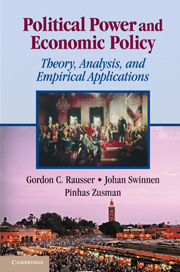Book contents
- Frontmatter
- Contents
- List of Figures
- List of Tables
- Preface
- PART 1 POLITICAL POWER AND ECONOMIC ANALYSIS
- PART 2 IDEOLOGY, PRESCRIPTION, AND POLITICAL POWER COEFFICIENTS
- PART 3 ANALYSIS OF SPECIFIC STRUCTURES
- 10 The Political Economy of Commodity Market Intervention
- 11 The Political Economy of Public Research and Development
- 12 Political-Economic Analysis of Redistributive Policies and Public Good Investments
- 13 Interest Groups, Coalition Breaking, and Productive Policies
- 14 Policy Reform and Compensation
- 15 Political-Economic Analysis of Land Reform
- 16 Political-Economic Analysis of Water Resource Systems
- 17 The Political Economy Lens on Quality and Public Standard Regulations
- 18 Political-Economic Analysis in Transition Economies
- 19 The Power of Bureaucracies: The European Commission and EU Policy Reforms
- PART 4 EMPIRICAL APPLICATIONS OF POLITICAL POWER ESTIMATION
- References
- Index
18 - Political-Economic Analysis in Transition Economies
Published online by Cambridge University Press: 05 June 2012
- Frontmatter
- Contents
- List of Figures
- List of Tables
- Preface
- PART 1 POLITICAL POWER AND ECONOMIC ANALYSIS
- PART 2 IDEOLOGY, PRESCRIPTION, AND POLITICAL POWER COEFFICIENTS
- PART 3 ANALYSIS OF SPECIFIC STRUCTURES
- 10 The Political Economy of Commodity Market Intervention
- 11 The Political Economy of Public Research and Development
- 12 Political-Economic Analysis of Redistributive Policies and Public Good Investments
- 13 Interest Groups, Coalition Breaking, and Productive Policies
- 14 Policy Reform and Compensation
- 15 Political-Economic Analysis of Land Reform
- 16 Political-Economic Analysis of Water Resource Systems
- 17 The Political Economy Lens on Quality and Public Standard Regulations
- 18 Political-Economic Analysis in Transition Economies
- 19 The Power of Bureaucracies: The European Commission and EU Policy Reforms
- PART 4 EMPIRICAL APPLICATIONS OF POLITICAL POWER ESTIMATION
- References
- Index
Summary
Introduction
The literature on the transitions in Central and Eastern Europe (CEE) and the Former Soviet Republics (FSR) has focused in part on a fundamental tradeoff inherent in any major political-economic transition process. On the one hand, if a transition is to be successful, the entrenched institutions of the old order must be removed to allow new familiar institutions to take root. On the other hand, the removal of the old order may result in social and economic disruption sufficient in scale to endanger the economic and political viability of the transition process itself. How should transition governments choose policies to safely navigate between the horns of this dilemma?
The literature on this question has been focused on justifying a priori either a “big-bang” or “gradualist” approach. As the debate has been framed, it boils down to the question of whether transition governments have enough état de grâce to implement the necessary but painful reforms required to establish a market-based economy.
At the core of any fundamental transition is the specification of the political process. Big-bangers, despite recognizing the existence of political constraints, do not explicitlymodel these constraints. Gradualists do model politics, but the frameworks they typically employ fail to adequately represent the political environment during a transition. In one form or another, gradualist models involve a single decision maker, “the government,” which acts as a Stackelberg leader in choosing a transition strategy. This model assumes that a well-established governance structure exists that allows a government to impose its decisions on society.
- Type
- Chapter
- Information
- Political Power and Economic PolicyTheory, Analysis, and Empirical Applications, pp. 348 - 379Publisher: Cambridge University PressPrint publication year: 2011



